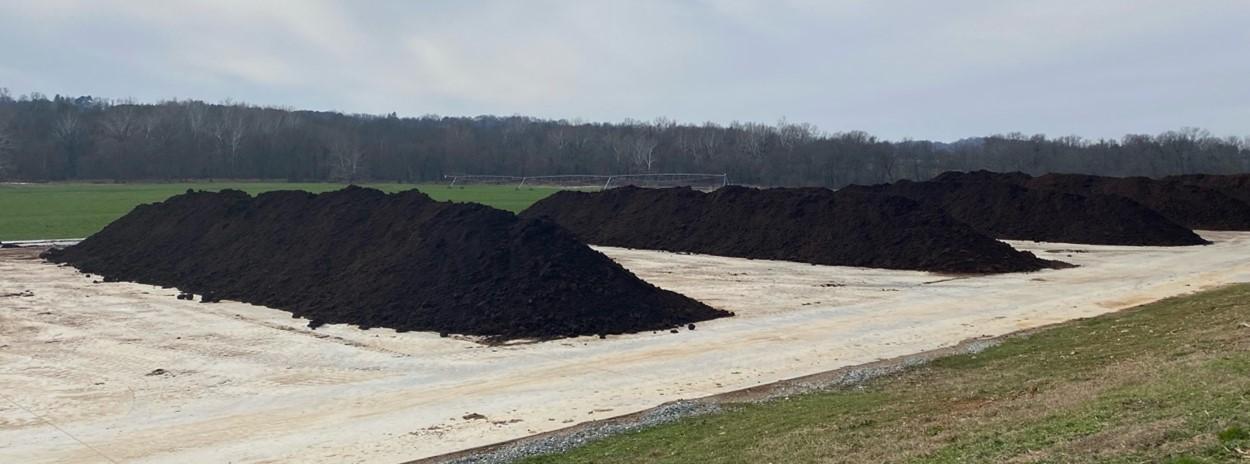Updated: October 31, 2024
Environmental Justice in Agricultural Waste Management (EBR-2023-0690)
This fact sheet introduces environmental justice and describes how vulnerable communities, including racial and ethnic minorities, are impacted by the introduction of new waste management technology across Maryland's Eastern Shore. Author's: Eric Burnstein, Mimi Sanford, Priscilla Alves, Higor Costa, and Marccus Hendricks; Title: Environmental Justice in Agricultural Waste Management (EBR-2023-0690).
Updated: October 31, 2024
Composting (FS-2023-0687)
Composting is an aerobic biological process that transforms organic materials, such as manure, food waste, and yard waste, into a nutrient-rich soil conditioner called “compost.” This Factsheet is part of the “Animal Waste Technology” series. Authors: Amro Hassanein, Stephanie Lansing, and Danielle Delp; Title: Composting (FS-2023-0687).
Updated: October 31, 2024
Using Thermochemical Processes to Handle Agricultural Waste (FS-2023-0688)
Thermochemical processing technologies can be used to reduce the volume of low moisture waste and produce heat, syngas for renewable energy production, biochar, or bio-oil, depending on the temperature and oxygen conditions used in processing. This Factsheet is part of the “Animal Waste Technology” series. Authors: Amro Hassanein, Stephanie Lansing, and Danielle Delp; Title: Using Thermochemical Processes to Handle Agricultural Waste (FS-2023-0688).
Updated: October 31, 2024
Anaerobic Digestion (EBR-2023-0686)
Anerobic digestion uses natural microorganisms to produce renewable energy in the form of electricity, heating, or vehicle fuel. Anaerobic digestion occurs inside a sealed reactor called a digester and reduces odors and greenhouse gas emissions. This Fact Sheet is part of the ‘Animal Waste Technology’ series. Authors: Amro Hassanein, Stephanie Lansing, and Danielle Delp; Title: Anaerobic Digestion (EBR-2023-0686).
Updated: October 8, 2024
A Case Study: Anaerobic Digestion of Dairy Manure and Food Processing Waste with Renewable Energy, Composting and Manure Injection (FS-2023-0694)
Anaerobic digestion of manure with food processing waste resulted in renewable electricity production for 190 house and reduced 81% of greenhouse gas emissions from manure management. The solids were separated from the manure for composting, with the digester effluent injected into the soil as a fertilizer. This FactSheet is part of the ‘Animal Waste Technology’ series. Authors: Kirkland Mahoney, Amro Hassanein, and Stephanie Lansing; Title: A Case Study: Anaerobic Digestion of Dairy Manure and Food Processing Waste with Renewable Energy, Composting and Manure Injection (FS-2023-0694).
 English
English العربية
العربية Български
Български 简体中文
简体中文 繁體中文
繁體中文 Hrvatski
Hrvatski Čeština
Čeština Dansk
Dansk Nederlands
Nederlands Suomi
Suomi Français
Français Deutsch
Deutsch Ελληνικά
Ελληνικά हिन्दी
हिन्दी Italiano
Italiano 日本語
日本語 한국어
한국어 Norsk bokmål
Norsk bokmål Polski
Polski Português
Português Română
Română Русский
Русский Español
Español Svenska
Svenska Català
Català Filipino
Filipino עִבְרִית
עִבְרִית Bahasa Indonesia
Bahasa Indonesia Latviešu valoda
Latviešu valoda Lietuvių kalba
Lietuvių kalba Српски језик
Српски језик Slovenčina
Slovenčina Slovenščina
Slovenščina Українська
Українська Tiếng Việt
Tiếng Việt Shqip
Shqip Eesti
Eesti Galego
Galego Magyar
Magyar Maltese
Maltese ไทย
ไทย Türkçe
Türkçe فارسی
فارسی Afrikaans
Afrikaans Bahasa Melayu
Bahasa Melayu Kiswahili
Kiswahili Gaeilge
Gaeilge Cymraeg
Cymraeg Беларуская мова
Беларуская мова Íslenska
Íslenska Македонски јазик
Македонски јазик יידיש
יידיש Հայերեն
Հայերեն Azərbaycan dili
Azərbaycan dili Euskara
Euskara ქართული
ქართული Kreyol ayisyen
Kreyol ayisyen اردو
اردو বাংলা
বাংলা Bosanski
Bosanski Cebuano
Cebuano Esperanto
Esperanto ગુજરાતી
ગુજરાતી Harshen Hausa
Harshen Hausa Hmong
Hmong Igbo
Igbo Basa Jawa
Basa Jawa ಕನ್ನಡ
ಕನ್ನಡ ភាសាខ្មែរ
ភាសាខ្មែរ ພາສາລາວ
ພາສາລາວ Latin
Latin Te Reo Māori
Te Reo Māori मराठी
मराठी Монгол
Монгол नेपाली
नेपाली ਪੰਜਾਬੀ
ਪੰਜਾਬੀ Afsoomaali
Afsoomaali தமிழ்
தமிழ் తెలుగు
తెలుగు Yorùbá
Yorùbá Zulu
Zulu ဗမာစာ
ဗမာစာ Chichewa
Chichewa Қазақ тілі
Қазақ тілі Malagasy
Malagasy മലയാളം
മലയാളം සිංහල
සිංහල Sesotho
Sesotho Basa Sunda
Basa Sunda Тоҷикӣ
Тоҷикӣ O‘zbekcha
O‘zbekcha አማርኛ
አማርኛ Corsu
Corsu Ōlelo Hawaiʻi
Ōlelo Hawaiʻi كوردی
كوردی Кыргызча
Кыргызча Lëtzebuergesch
Lëtzebuergesch پښتو
پښتو Samoan
Samoan Gàidhlig
Gàidhlig Shona
Shona سنڌي
سنڌي Frysk
Frysk isiXhosa
isiXhosa


